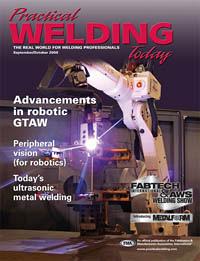- FMA
- The Fabricator
- FABTECH
- Canadian Metalworking
Categories
- Additive Manufacturing
- Aluminum Welding
- Arc Welding
- Assembly and Joining
- Automation and Robotics
- Bending and Forming
- Consumables
- Cutting and Weld Prep
- Electric Vehicles
- En Español
- Finishing
- Hydroforming
- Laser Cutting
- Laser Welding
- Machining
- Manufacturing Software
- Materials Handling
- Metals/Materials
- Oxyfuel Cutting
- Plasma Cutting
- Power Tools
- Punching and Other Holemaking
- Roll Forming
- Safety
- Sawing
- Shearing
- Shop Management
- Testing and Measuring
- Tube and Pipe Fabrication
- Tube and Pipe Production
- Waterjet Cutting
Industry Directory
Webcasts
Podcasts
FAB 40
Advertise
Subscribe
Account Login
Search
Stainless Steel Workshop: Storing and reconditioning filler metals
- By Jeff Heagey
- April 6, 2015
- Article
- Metals/Materials
For years fabricators have questioned the need for properly storing opened containers of electrodes in a controlled environment. The cost of holding ovens, as well as the discipline required to use them, has had fabricators second-guessing the benefits of such a practice. Regardless of the type of filler metal you use, the need to following the practice has never been greater
Covered electrodes and cored wire are the most sensitive to moisture. Many of the ingredients used to extrude electrodes or fabricate wires are sensitive to moisture pickup. Exposed electrodes can absorb moisture as the temperature and humidity rise. An electrode exposed at 70 degrees F and 70 percent humidity will absorb moisture more slowly than one at 90 degrees F and 90 percent humidity. Controlling the exposure can make a difference in the overall quality and performance of the product.
Moisture is one of the primary sources of hydrogen in weld metal. Hydrogen comes in many forms, both on the plate and in the filler material. Eliminating the source of moisture will minimize the overall cost and prevent premature weld failure.
The American Welding Society has begun to impose hydrogen standards on various filler metal products by instituting a hydrogen designation system. By giving products a designation such as H4, which restricts the use of the product once the hydrogen has exceeded 4 ml per 100 grams, AWS has forced fabricators to re-evaluate their practices.
Filler metal manufacturers should be able to provide you with the recommended storing and reconditioning temperature. Typically electrodes are stored and reconditioned at the following temperatures:
About the Author
Jeff Heagey
ESAB Welding & Cutting Products
717-630-3445
About the Publication
Related Companies
subscribe now

The Welder, formerly known as Practical Welding Today, is a showcase of the real people who make the products we use and work with every day. This magazine has served the welding community in North America well for more than 20 years.
start your free subscription- Stay connected from anywhere

Easily access valuable industry resources now with full access to the digital edition of The Fabricator.

Easily access valuable industry resources now with full access to the digital edition of The Welder.

Easily access valuable industry resources now with full access to the digital edition of The Tube and Pipe Journal.
- Podcasting
- Podcast:
- The Fabricator Podcast
- Published:
- 04/16/2024
- Running Time:
- 63:29
In this episode of The Fabricator Podcast, Caleb Chamberlain, co-founder and CEO of OSH Cut, discusses his company’s...
- Trending Articles
Sheffield Forgemasters makes global leap in welding technology

Welding student from Utah to represent the U.S. at WorldSkills 2024

Lincoln Electric announces executive appointments

Lincoln Electric acquires RedViking

Engine-driven welding machines include integrated air compressors

- Industry Events
16th Annual Safety Conference
- April 30 - May 1, 2024
- Elgin,
Pipe and Tube Conference
- May 21 - 22, 2024
- Omaha, NE
World-Class Roll Forming Workshop
- June 5 - 6, 2024
- Louisville, KY
Advanced Laser Application Workshop
- June 25 - 27, 2024
- Novi, MI




























